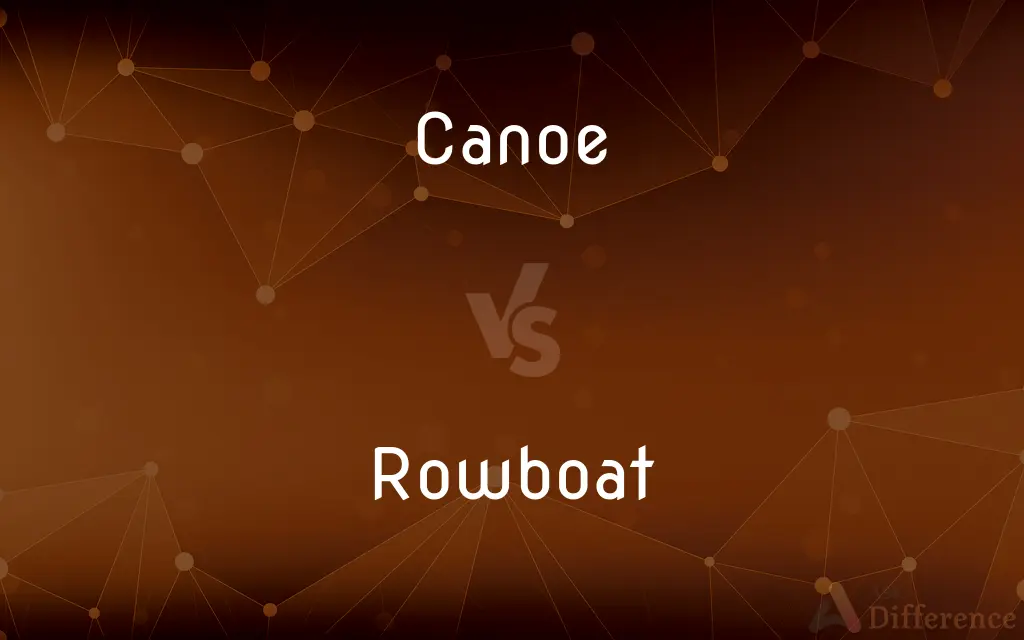Canoe vs. Rowboat — What's the Difference?
By Tayyaba Rehman & Fiza Rafique — Updated on March 7, 2024
Canoe is a lightweight, narrow vessel pointed at both ends, propelled by one or more paddles. Rowboat is a broader, more stable boat powered by rows of oars.

Difference Between Canoe and Rowboat
Table of Contents
ADVERTISEMENT
Key Differences
Canoeing involves paddling from a kneeling or seated position with a single-bladed paddle, focusing on maneuverability and speed in various water conditions. Whereas, rowing a rowboat requires the rower to sit facing backward, using a set of oars on either side of the boat for propulsion, emphasizing stability and strength.
Canoes are traditionally made from materials like wood, bark, or modern composites, designed for efficiency and speed in water. On the other hand, rowboats are often constructed from heavier materials such as wood, aluminum, or fiberglass, designed for durability and stability.
The design of a canoe is streamlined, with a narrow, open top that allows for quick movement through water, but it can be more prone to tipping. Rowboats, with their wider hull and flat bottom, offer more stability and are less likely to capsize, making them suitable for beginners or casual boating.
Canoes are versatile and used for a variety of activities, from recreational paddling to competitive racing and wilderness trips. In contrast, rowboats are commonly used for leisurely activities, fishing, and as tenders for larger ships, due to their stability and ease of use.
The seating arrangement in canoes allows for solo or tandem paddling, offering flexibility in how they are maneuvered. Rowboats, however, typically have fixed seats that accommodate two or more rowers, providing a steady and controlled rowing experience.
ADVERTISEMENT
Comparison Chart
Propulsion
Paddled with single-bladed paddles
Rowed with double-bladed oars
Position
Paddling from kneeling or seated position
Rowing seated facing backward
Material
Wood, bark, composites
Wood, aluminum, fiberglass
Design
Streamlined, narrow, open top
Wider hull, flat bottom, more stable
Stability
Less stable, more prone to tipping
More stable, less likely to capsize
Use
Recreational paddling, racing, wilderness trips
Leisurely activities, fishing, tenders for larger ships
Seating
Flexible, solo or tandem paddling
Fixed seats, accommodates two or more rowers
Compare with Definitions
Canoe
A lightweight, narrow boat propelled by paddles.
We glided across the lake in a canoe, the water calm and clear.
Rowboat
A sturdy boat powered by oars.
We spent the afternoon rowing the rowboat around the pond.
Canoe
Often used for competitive racing and wilderness exploration.
They embarked on a week-long canoe trip down the river.
Rowboat
Features a wide hull for stability.
The rowboat's wide hull made it feel safe even in choppy water.
Canoe
Traditional construction from wood or modern composites.
The handmade wooden canoe was a work of art.
Rowboat
Suitable for fishing and leisurely boating.
They took the rowboat out to the middle of the lake to fish.
Canoe
Designed for speed and maneuverability in water.
The canoe cut swiftly through the river's rapids.
Rowboat
Used as tenders for larger vessels.
The rowboat ferried passengers to the anchored yacht.
Canoe
Can be paddled solo or with a partner.
She preferred solo canoeing, enjoying the peace of the water.
Rowboat
Typically seats two or more people.
The family enjoyed rowing the boat together, taking turns with the oars.
Canoe
A canoe is a lightweight narrow water vessel, typically pointed at both ends and open on top, propelled by one or more seated or kneeling paddlers facing the direction of travel and using a single-bladed paddle.In British English, the term "canoe" can also refer to a kayak, while canoes are then called Canadian or open canoes to distinguish them from kayaks. Canoes were developed by cultures all over the world, including some designed for use with sails or outriggers.
Rowboat
A small boat propelled by oars.
Canoe
A light, slender, usually open boat that has pointed ends and is propelled by paddles.
Rowboat
(US) A small open boat propelled by oars (by rowing).
Canoe
To carry or send by canoe.
Rowboat
(intransitive) To row a boat of this kind.
Canoe
To travel in or propel a canoe.
Rowboat
A boat designed to be propelled by oars instead of sails.
Canoe
A small long and narrow boat, propelled by one or more people (depending on the size of canoe), using single-bladed paddles. The paddlers face in the direction of travel, in either a seated position, or kneeling on the bottom of the boat. Canoes are open on top, and pointed at both ends.
Rowboat
A small boat of shallow draft with cross thwarts for seats and rowlocks for oars with which it is propelled
Canoe
(slang) An oversize, usually older, luxury car.
Canoe
(gambling) Any of the deflectors positioned around a roulette wheel, shaped like upside-down boats.
Canoe
To ride or paddle a canoe.
Canoe
A boat used by rude nations, formed of trunk of a tree, excavated, by cutting of burning, into a suitable shape. It is propelled by a paddle or paddles, or sometimes by sail, and has no rudder.
Others devised the boat of one tree, called the canoe.
Canoe
A boat made of bark or skins, used by savages.
A birch canoe, with paddles, rising, falling, on the water.
Canoe
A light pleasure boat, especially designed for use by one who goes alone upon long excursions, including portage. It it propelled by a paddle, or by a small sail attached to a temporary mast.
Canoe
To manage a canoe, or voyage in a canoe.
Canoe
Small and light boat; pointed at both ends; propelled with a paddle
Canoe
Travel by canoe;
Canoe along the canal
Common Curiosities
What is the main difference between a canoe and a rowboat?
The main difference lies in their design, use, and method of propulsion; canoes are paddled with a single-bladed paddle, while rowboats are rowed with double-bladed oars.
Can rowboats be used in rough waters?
Rowboats, due to their stability and sturdy construction, can be used in rough waters, but their performance and safety depend on the skill of the rower and the size of the waves.
Can you use a canoe for fishing?
Yes, canoes can be used for fishing, especially in narrow or shallow waters where their maneuverability and quiet movement are advantageous.
What kind of maintenance do canoes and rowboats require?
Both canoes and rowboats require regular maintenance, including cleaning, inspection for damages, and repairs. Canoes may need additional care for their lightweight materials, while rowboats might require painting or sealing to prevent rust or water damage.
Which is easier to transport, a canoe or a rowboat?
Canoes are typically easier to transport because of their lighter weight and narrower design, which makes them more manageable on car racks or trailers.
Do you need a license to operate a canoe or rowboat?
In many places, you do not need a license to operate a canoe or rowboat for recreational use, but it's important to check local regulations regarding watercraft.
Is a canoe or rowboat faster?
A canoe is generally faster due to its streamlined shape and lighter weight, making it more efficient for paddling at speed.
Are canoes or rowboats more environmentally friendly?
Both can be environmentally friendly options, especially when made from sustainable materials and used without disturbing natural habitats. Their human-powered nature makes them low-impact on ecosystems.
How many people can a rowboat accommodate?
The capacity of a rowboat depends on its size, but many can comfortably accommodate four or more passengers, making them suitable for group activities.
Can you stand up in a canoe or rowboat?
Standing up in a canoe is possible but risky due to instability, while standing in a rowboat is generally safer because of its wider hull and flat bottom, although caution is always advised.
What accessories are essential for canoeing and rowing?
Essential accessories include life jackets, paddles or oars, waterproof bags for personal items, and possibly a bailer for removing water. For extended trips, navigation tools and repair kits are also important.
Share Your Discovery

Previous Comparison
Lumenal vs. Luminal
Next Comparison
Shlub vs. SchlubAuthor Spotlight
Written by
Tayyaba RehmanTayyaba Rehman is a distinguished writer, currently serving as a primary contributor to askdifference.com. As a researcher in semantics and etymology, Tayyaba's passion for the complexity of languages and their distinctions has found a perfect home on the platform. Tayyaba delves into the intricacies of language, distinguishing between commonly confused words and phrases, thereby providing clarity for readers worldwide.
Co-written by
Fiza RafiqueFiza Rafique is a skilled content writer at AskDifference.com, where she meticulously refines and enhances written pieces. Drawing from her vast editorial expertise, Fiza ensures clarity, accuracy, and precision in every article. Passionate about language, she continually seeks to elevate the quality of content for readers worldwide.














































